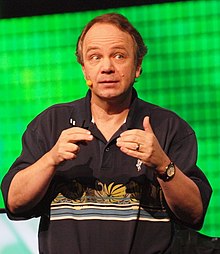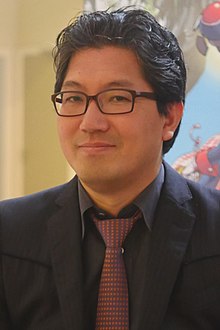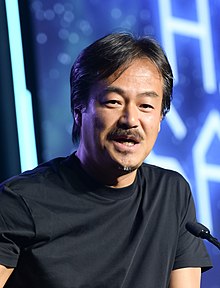Portal:Video games
Portal maintenance status: (April 2019)
|
The Video Games Portal

A video game, sometimes further qualified as a computer game, is an electronic game that involves interaction with a user interface or input device (such as a joystick, controller, keyboard, or motion sensing device) to generate visual feedback from a display device, most commonly shown in a video format on a television set, computer monitor, flat-panel display or touchscreen on handheld devices, or a virtual reality headset. Most modern video games are audiovisual, with audio complement delivered through speakers or headphones, and sometimes also with other types of sensory feedback (e.g., haptic technology that provides tactile sensations). Some video games also allow microphone and webcam inputs for in-game chatting and livestreaming.
Video games are typically categorized according to their hardware platform, which traditionally includes arcade video games, console games, and computer games (which includes LAN games, online games, and browser games). More recently, the video game industry has expanded onto mobile gaming through mobile devices (such as smartphones and tablet computers), virtual and augmented reality systems, and remote cloud gaming. Video games are also classified into a wide range of genres based on their style of gameplay and target audience. (Full article...)
Featured articles – load new batch
-
Image 1Metroid Prime 2: Echoes is a 2004 adventure game developed by Retro Studios and published by Nintendo for the GameCube. The sequel to Metroid Prime (2002) and the first Metroid game with a multiplayer feature, Echoes was released in North America, Europe and Australia in 2004 and in Japan under the name Metroid Prime 2: Dark Echoes in May 2005.
The story follows bounty hunter Samus Aran after she is sent to rescue Galactic Federation Marines from a ship near Aether, a planet inhabited by a race known as the Luminoth. She discovers that the troops were slaughtered by the Ing, a hostile race that came from an alternate dimension of Aether. Samus must travel to four temples to ensure the destruction of the evil Ing, while battling them, wild creatures, Space Pirates, and her mysterious doppelgänger Dark Samus.
Retro sought to differentiate Echoes with a heavier focus on story-telling and new gameplay mechanics. Nintendo launched a viral marketing campaign that included several websites written as if taking place in the Metroid universe. The single-player mode was acclaimed for its graphics, atmosphere and music, though its steep difficulty and multiplayer mode were met less positively. (Full article...) -
Image 2Half-Life 2: Lost Coast is an additional level for the 2004 first-person shooter game Half-Life 2. Developed by Valve, it was released on October 27, 2005, as a free download for owners of Half-Life 2 on Steam. Players control Half-Life protagonist Gordon Freeman as he travels up a coastal cliff to destroy a Combine weapon in a monastery.
Lost Coast is a technology demonstration showcasing the high-dynamic-range rendering implemented in the Source engine. It was designed with environments to emphasize these effects. Lost Coast was the first Valve game with a commentary mode, in which the developers explain elements of design as the player progresses through the level.
The Lost Coast level was created for Half-Life 2, but was removed from the game. It was originally going to be a level in "Highway 17" where Gordon ends up in a strange place meeting a Fisherman. As a result, it has several minor story details that were not included in Half-Life 2. It received a generally positive reception, and there was consensus among reviewers that the new features included in Lost Coast should be integrated into future games released by Valve. (Full article...) -
Image 3Knuckles' Chaotix is a 1995 platform game developed by Sega for the 32X. A spin-off from the Sonic the Hedgehog series, it features Knuckles the Echidna and four other characters known as the Chaotix, who must prevent Doctor Robotnik and Metal Sonic from obtaining six magic rings and conquering a mysterious island. The gameplay is similar to previous Sonic games: players complete levels while collecting rings and defeating enemies. Knuckles' Chaotix introduces a partner system whereby the player is connected to another character via a tether; the tether behaves like a rubber band and must be used to maneuver the characters.
While Sonic Team is sometimes credited with creating Knuckles' Chaotix, it was developed by another Sega team. Production began with Sonic Crackers, a 1994 prototype for the Sega Genesis which experimented with the tethering system and featured Sonic and Tails. Knuckles' Chaotix was planned as a Sonic game for the Sega Saturn, but transitioned to the 32X when it could not be completed in time. Sonic and Tails were replaced by Knuckles and a group of mostly pre-existing characters; Mighty the Armadillo first appeared in the arcade game SegaSonic the Hedgehog (1993).
Knuckles' Chaotix was released in North America and Japan in April 1995, and in Europe in June 1995. It received mixed contemporary reviews and failed commercially. Reviewers found the tethering physics cumbersome, although some appreciated it as an attempt to innovate. The level design and low difficulty level were also criticized. Journalists have described Knuckles' Chaotix as the last of the "classic" 2D Sonic games before the series moved to 3D. Some characters and concepts it introduced feature in later Sonic games and media, beginning with Sonic Heroes in 2003. Despite interest from fans, it has not been rereleased beyond a brief period through GameTap in the mid-2000s. (Full article...) -
Image 4

The Capcom Five, as originally announced, represented an unprecedented level of third-party developer support for the GameCube.
The Capcom Five are five video games that were unveiled by Capcom in late 2002 and published from March 2003. At a time when Nintendo's GameCube console had failed to capture market share, Capcom announced five new GameCube titles with the apparent goal of boosting hardware sales and demonstrating third-party developer support. Capcom USA followed up with confirmation that they would be exclusive to the GameCube. The five games were P.N.03, a futuristic third-person shooter; Viewtiful Joe, a side-scrolling action-platformer; Dead Phoenix, a shoot 'em up; Resident Evil 4, a survival horror third-person shooter; and Killer7, an action-adventure game with first-person shooter elements. Though not directly related to each other, they were all overseen by Resident Evil director Shinji Mikami and, except Killer7, developed by Capcom's Production Studio 4. Capcom USA later clarified that only Resident Evil 4 was intended to be exclusive; the initial announcement was due to a miscommunication with their parent company.
Of the five games, Dead Phoenix was canceled and only P.N.03 remained a GameCube exclusive. P.N.03 received mixed reviews and was a commercial failure, but is now considered a "cult classic". Both Viewtiful Joe and Killer7 sold modestly, the former despite critical acclaim and the latter owing to polarized reviews. Killer7 gained a significant cult following, effectively launching the career of director Suda51. Resident Evil 4 was the runaway success of the five, though its GameCube sales were undercut by the announcement of a PlayStation 2 port to be released later in 2005. Viewtiful Joe also saw a PlayStation 2 version with expanded features, and Killer7 debuted on multiple platforms simultaneously. Since the release of the Nintendo 64, Nintendo struggled to attract third-party developers like Capcom to produce games for its systems. Industry analysts see the Capcom Five case, particularly the loss of GameCube exclusivity for Resident Evil 4, as a major blow to Nintendo–Capcom relations and is emblematic of Nintendo's failure to attract third-party support during the GameCube era. (Full article...) -
Image 5Hotline Miami 2: Wrong Number is a 2015 top-down shooter video game developed by Dennaton Games and published by Devolver Digital. The game takes place before, during, and after the events of Hotline Miami (2012), focusing on the background and aftermath of the massacres committed against the Russian mafia in Miami by Jacket, the protagonist of the previous game. The player takes on the role of several different characters during the game, witnessing the events from different perspectives across the United States. In each level of the game, the player is tasked with defeating every enemy through any means possible. In the version of the game released on Steam, the player has access to a level editor, allowing them to create and share custom levels with other players.
The game was initially conceived as downloadable content for the previous game, but became a standalone sequel after its length surpassed that of the original. The game was first announced in December 2012 via Jonatan Söderström's Twitter. Developed as the final installment in the series, Dennaton incorporated all unused concepts from the first game's development into the sequel. The game's console versions were developed by Abstraction Games. It was formally announced at E3 2013, and after a few delays, was released worldwide on 10 March 2015 for Linux, OS X, PlayStation 3, PlayStation 4, PlayStation Vita, and Windows.
Hotline Miami 2: Wrong Number received generally positive reviews from critics, who praised the soundtrack, but had diverse opinions on the gameplay, level design and ending. A scene depicting sexual assault triggered a mostly negative response from media outlets and resulted in the game being refused classification in Australia. A localised version was released in Japan on 25 June 2015 as part of Hotline Miami: Collected Edition. The game was ported onto Nintendo Switch alongside the first game in the Hotline Miami Collection in 2019, which was later ported onto the Xbox One and Stadia in 2020 and the PlayStation 5 and Xbox Series X/S in 2023. (Full article...) -
Image 6Master Chief Petty Officer John-117, colloquially known as Master Chief, is the protagonist of the Halo video game series and its spin-off media. The character first appeared in the 2001 video game Halo: Combat Evolved, a science fiction first-person shooter that became a long-running franchise. The character also appears in spin-off Halo media such as the 2012 film Halo 4: Forward Unto Dawn, the 2022 Halo television series, and several graphic novels and books.
The Master Chief is a towering supersoldier known as a "Spartan", trained from childhood for combat. The designers intended for players to be able to project their own intentions into the character and thus reduced his voiced lines and concealed his appearance under his armor. In the video games, the character is voiced by former disc jockey Steve Downes, who based his performance on Bungie's description calling for a man of few words, similar to Clint Eastwood. In spin-off media, he is portrayed by different voice and physical actors, most notably Pablo Schreiber on the 2022 live-action TV series.
A pop culture icon, Master Chief is widely regarded as one of the greatest video game characters of all time, with the character being seen as a mascot for Halo and the Xbox brand. His 2001 debut received a generally positive reception for his character design, with publications praising how the narrative allows players to inhabit the character, while others have criticized him as under characterized. In later Halo games developed by 343 Industries, the characterization of Master Chief earned praise for exploring his humanity and his relationship with Cortana. (Full article...) -
Image 7Bastion is an action role-playing video game developed by independent developer Supergiant Games and originally published in 2011 by Warner Bros. Interactive Entertainment. In the game, the player controls "the Kid" as he moves through floating, fantasy-themed environments and fights enemies of various types. It features a dynamic voiceover from a narrator (Logan Cunningham), and is presented as a two-dimensional game with an isometric camera and a hand-painted, colorful art style. Bastion's story follows the Kid as he collects special shards of rock to power a structure, the Bastion, in the wake of an apocalyptic Calamity.
The game was built over the course of two years by a team of seven people split between San Jose and New York City. They debuted the game at the September 2010 Penny Arcade Expo, and it went on to be nominated for awards at the 2011 Independent Games Festival and win awards at the Electronic Entertainment Expo prior to release. Bastion was published in July 2011 for Xbox 360 via Xbox Live Arcade, and in August 2011 through digital distribution for Microsoft Windows on Steam. Supergiant Games made it available as a browser game for Google Chrome in December 2011. It was released for Mac OS X and iOS in 2012, for PlayStation 4 and PlayStation Vita in 2015, for Xbox One in 2016, and Nintendo Switch in 2018. Bastion's soundtrack was produced and composed by Darren Korb, and a soundtrack album was made available for sale in August 2011.
During 2011, the game sold more than 500,000 copies, 200,000 of which were for the Xbox Live Arcade. It sold over three million copies across all platforms by January 2015. The game was widely praised by reviewers, primarily for its story, art direction, narration, and music. Opinions were mixed on the depth of the gameplay, though the variety of options in the combat system was praised. Bastion has won many nominations and awards since its release, including several for best downloadable game and best music, from review outlets such as IGN and Game Informer as well as from the Spike Video Game Awards, the Game Developers Conference, and the Academy of Interactive Arts & Sciences. (Full article...) -
Image 8Kingdom Two Crowns is a 2018 strategy video game developed by Thomas van den Berg and Coatsink and published by Raw Fury. It is the third entry in the Kingdom series. Players control a mounted monarch as they attempt to defend their kingdom from a race of monsters called the Greed. The monarch can recruit villagers to perform certain jobs while building defenses such as towers and walls to fend off waves of Greed attacking the kingdom at night. Kingdom Two Crowns features single-player and cooperative multiplayer modes, with cooperative play enabling two monarchs to join via a split screen.
The developers originally designed Kingdom Two Crowns as an expansion pack for Kingdom: New Lands (2016). As the expansion grew, they decided to release it as a separate game. The series' creator, van den Berg, wanted to develop a new experience centered around defending structures. The developers chose to lessen the difficulty of the previous games' roguelike mechanics, and used a pixel art style to reduce the time between drawing and implementing new designs in gameplay.
Kingdom Two Crowns was released for Windows, macOS, PlayStation 4, Nintendo Switch, and Xbox One on December 11, 2018, and for iOS and Android on April 28, 2020. It received positive reviews, gaining praise for its strategic gameplay, artwork, and cooperative play, though its slow pace was criticized. The game attracted over 300,000 players within six months of launch, and was supported by Raw Fury with several updates and downloadable content. (Full article...) -
Image 9Populous: The Beginning is a real-time strategy video game and the third entry in the Populous series, developed by Bullfrog Productions. The game was released in 1998 on Microsoft Windows, and in 1999 for the PlayStation. Unlike earlier games in the series, which cast the player in the role of a god influencing loyal followers, The Beginning took a radical departure and placed the player in the role of a shaman, who directly leads her tribe against opponents. Throughout the twenty-five missions of the campaign, the player leads their tribe across a solar system, dominating enemy tribes and tapping new sources of magic, with the ultimate goal of the shaman attaining godhood herself.
Populous: The Beginning was the first entry in the series to use 3D computer graphics; Bullfrog waited four years after Populous II: Trials of the Olympian Gods so that the graphics technology could catch up to their vision for a new and different game in the series. The developers considered the addition of terrain deformation and manipulation, combined with "smart" villagers who automatically attended to tasks, to add an entirely new dimension to the series. The game's original title was Populous: The Third Coming before being changed prior to the beta release.
Populous: The Beginning plays very differently from earlier titles and received mixed reviews. Critics noted the excellent graphics, while complaints were directed at the artificial intelligence and the indecision in game design between being a real time strategy title and a god game. GamePro's Peter Olafson wrote that Populous: The Beginning was a good game but was "without a quintessential quality that defined Populous." (Full article...) -
Image 10Deathrow is a 2002 sports video game developed by Southend Interactive and published by Ubi Soft for the Xbox as an exclusive. Deathrow's development began in May 1999 as an online PC game. In early 2001, Southend transitioned to an Xbox console release, which let the team use pixel shaders, bump mapped textures, and specular lighting. Deathrow was built on an in-house 3D game engine and was Southend's first full release.
The game is based on the fictional extreme sport Blitz, a futuristic full-contact hybrid of hockey and basketball played with a flying disc. Two teams of four players attempt to move the disc through their opponent's goal, and teams can either win on points or by knocking out their opposing team. There are 150 individual characters across 18 thematic teams. The single-player campaign's plot is set in the 23rd century, when Blitz is a popular, televised sport and the teams battle to scale the ranks and win the championship. Players earn credits from their goals scored, opponent knockouts, and crowd-pleasing to be spent on player upgrades, bets, and new teammates. The game also supports split-screen and System Link multiplayer for up to eight players across up to eight Xbox consoles.
Deathrow received largely favorable reviews. Reviewers praised the game's fast-paced action, and surround sound, but complained of its high difficulty curve, generic soundtrack, and lack of online multiplayer. Some critics felt the game's use of profanity was excessive, while others thought it was a highlight. Reviewers considered the game's concept and mechanics similar to other series, specifically Speedball. IGN and TeamXbox both named Deathrow an Editor's Choice. The game won the TeamXbox 2002 Breakthrough Game of the Year award and the IGN 2002 Best Game Nobody Played. IGN later reported that a sequel would be unlikely due to the original's low revenue. Southend dissolved in 2013. (Full article...)
Did you know... - show different entries
- ... that Justin Yu, the current Classic Tetris World Champion, is also a cellist in MIT's video game orchestra?
- ... that a version of the video game Rhino Rumble was not released due to the creators not wanting to add licensed characters?
- ... that MicroProse was formed to publish Hellcat Ace after Sid Meier boasted that he could design a better video game than Red Baron in a week?
- ... that Kim Kitsuragi was praised as one of the best video game characters of 2019?
- ... that Rockstar Vienna was the largest video game developer in Austria when it closed in 2006?
- ... that fighting video game Panza Kick Boxing was endorsed by a French kickboxing champion who also supplied technical advice?
- ... that the urban legend Herobrine was ranked on a Guinness World Records poll of the best video game villains, despite never existing?
- ... that the video game JFK Reloaded recreates the assassination of John F. Kennedy from the perspective of the killer?
- ... that the concept of adding strippers to the extreme sports video game BMX XXX was initially proposed in jest?
- ... that the game designer of the video game Hades said that the characters were attractive "because Jen Zee"?
- ... that Goodboy Galaxy was the first commercially released video game for the Game Boy Advance in more than 13 years?
- ... that classified documents of the United States were partially leaked onto a Discord server for the video game Minecraft?
Selected biography – load new batch
-
Image 1
Richard Allen Garriott (born 4 July 1961) is a British-born American video game developer, entrepreneur and private astronaut.
Garriott, who is the son of NASA astronaut Owen Garriott, was originally a game designer and programmer, and is now involved in a number of aspects of computer-game development. On October 12, 2008, Garriott flew aboard the Soyuz TMA-13 mission to the International Space Station as a private astronaut, returning 12 days later aboard Soyuz TMA-12. He became the second space traveler, and first from the United States, to have a parent who was also a space traveler. During his ISS flight, he filmed a science fiction movie Apogee of Fear. (Full article...) -
Image 2
Jordan Mechner (born June 4, 1964) is an American video game designer, author, screenwriter, filmmaker, and former video game programmer. A major figure in the development of cinematic video games and a pioneer in video game animation, he began his career designing and programming the bestselling 1984 martial arts game Karateka for the Apple II while a student at Yale University. He followed it with the platform game Prince of Persia five years later; it was widely ported and became a hit. Both games used rotoscoping, where actors shot on film by Mechner were drawn over to create in-game animation. Prince of Persia has become the basis for a long-running franchise, including a 2010 live-action film released by Walt Disney Pictures and an ongoing series of video games published by Ubisoft.
Mechner is the recipient of many accolades, including the 2017 GDC Pioneer Award. His works are often included in all-time lists of the game industry's best and most influential titles. (Full article...) -
Image 3
William Murray "Trip" Hawkins III (born December 28, 1953) is an American entrepreneur and founder of Electronic Arts, The 3DO Company, and Digital Chocolate. (Full article...) -
Image 4Morhaime at BlizzCon 2009
Michael Morhaime (born November 3, 1967) is an American video game developer and entrepreneur. He is the chief executive officer (CEO) and founder of Dreamhaven, located in Irvine, California. Morhaime is best known as the co-founder and the former president of Blizzard Entertainment, a subsidiary of Activision Blizzard, Inc., that was founded in 1991 as Silicon & Synapse. He served on the Vivendi Games executive committee from January 1999, when Blizzard Entertainment, Inc. became a subsidiary of Vivendi Games, until July 2008. (Full article...) -
Image 5Hiroshi Yamauchi (山内溥, Yamauchi Hiroshi, 7 November 1927 – 19 September 2013) was a Japanese businessman and the third president of Nintendo, joining the company on 25 April 1949 until stepping down on 24 May 2002, being succeeded by Satoru Iwata. During his 53-year tenure, Yamauchi transformed Nintendo from a hanafuda card-making company that had been active solely in Japan into a multibillion-dollar video game publisher and global conglomerate. He was the great-grandson of Fusajiro Yamauchi, Nintendo's first president and founder. Hiroshi Yamauchi owned the Seattle Mariners baseball team from 1992 until his death.
In April 2013, Forbes estimated Yamauchi's net worth at $2.1 billion; he was the 13th richest person in Japan and the 491st richest in the world. In 2008, Yamauchi was Japan's wealthiest person with a fortune at that time estimated at $7.8 billion. At the time of his death, Yamauchi was the largest shareholder at Nintendo. (Full article...) -
Image 6Romero at the Game Developers Conference in 2022
Alfonso John Romero (born October 28, 1967) is an American video game developer. He co-founded id Software and designed their early games, including Wolfenstein 3D (1992), Doom (1993), Doom II (1994), Hexen (1995) and Quake (1996). His designs and development tools, along with programming techniques developed by the id programmer John Carmack, popularized the first-person shooter (FPS) genre. Romero is also credited with coining the multiplayer term "deathmatch".
Following disputes with Carmack, Romero was fired from id in 1996. He co-founded a new studio, Ion Storm, and directed the FPS Daikatana (2000), which was a critical and commercial failure. Romero departed Ion Storm in 2001. In July 2001, he and another former id employee, Tom Hall, founded Monkeystone Games to develop games for mobile devices. (Full article...) -
Image 7
James D. Rolfe (born July 10, 1980) is an American YouTuber, filmmaker, and actor. He is best known for creating and starring in the comedic retrogaming web series Angry Video Game Nerd (2004–present). His spin-off projects include reviews of retro films, television series, and board games. He is considered a pioneer of internet gaming videos and is noted for his widespread influence on YouTube content after the series premiered on the platform in 2006.
Rolfe began creating homemade video productions in the late 1980s, having made more than 270 videos and short films by 2004. Among these were the first Angry Video Game Nerd episodes (originally known as Bad NES Games, and later Angry Nintendo Nerd), which were released on his Cinemassacre website in 2004. Two years later, he gained mainstream attention when the series went viral after being published to YouTube. Following its success, Rolfe released a feature-length film based on the series in 2014, which received a mixed reception. (Full article...) -
Image 8Koji Kondo (Japanese: 近藤 浩治, Hepburn: Kondō Kōji, born August 13, 1961) is a Japanese composer and senior executive at the video game company Nintendo. He is best known for his contributions for the Super Mario and The Legend of Zelda series, with his Super Mario Bros. theme being the first piece of music from a video game included in the American National Recording Registry. Kondo was hired by Nintendo in 1984 as their first dedicated composer and is currently a Senior Officer at their Entertainment Planning & Development division. (Full article...)
-
Image 9
Steven Scott Ritchie (born February 13, 1950) is an American pinball and video game designer. His career began in the 1970s. Ritchie holds the record for best-selling pinball designer in history. He has been called "The Master of Flow" due to the emphasis in his designs on ball speed, loops, and long smooth shots. Ritchie was also the original voice of Shao Kahn in the Mortal Kombat fighting game series, serving as the announcer of Mortal Kombat II (1993), Mortal Kombat 3 (1995), and the updates to Mortal Kombat 3. He is the older brother of fellow pinball designer Mark Ritchie. (Full article...) -
Image 10Satoshi Tajiri (Japanese: 田尻 智, Hepburn: Tajiri Satoshi, born August 28, 1965) is a Japanese video game designer and director who is the creator of the Pokémon franchise and the co-founder and president of video game developer Game Freak.
A fan of arcade games in his youth, Tajiri wrote for and edited his own video gaming fanzine Game Freak with Ken Sugimori, before evolving it into a development company of the same name. Tajiri claims that the joining of two Game Boys via a link cable inspired him to create a game which embodied the collection and companionship of his childhood hobby, insect collecting. The game, which became Pokémon Red and Pokémon Green, took six years to complete and went on to spark a multibillion-dollar franchise which reinvigorated Nintendo's handheld gaming scene. Tajiri continued to work as director for the Pokémon series until the development of Pokémon Ruby and Sapphire, when he changed his role to executive producer, which he holds to this day. (Full article...) -
Image 11
Richard Allan Bartle (born 10 January 1960) is a British writer, professor and game researcher in the massively multiplayer online game industry. He co-created MUD1 (the first MUD) in 1978, and is the author of the 2003 book Designing Virtual Worlds. (Full article...) -
Image 12
Timothy John Schafer (born July 26, 1967) is an American video game designer. He founded Double Fine Productions in July 2000, after having spent over a decade at LucasArts. Schafer is best known as the designer of critically acclaimed games Full Throttle, Grim Fandango, Psychonauts, Brütal Legend and Broken Age, co-designer of Day of the Tentacle, and assistant designer on The Secret of Monkey Island and Monkey Island 2: LeChuck's Revenge. He is well known in the video game industry for his storytelling and comedic writing style, and has been given both a Lifetime Achievement Award from the Game Developers Choice Awards, and a BAFTA Fellowship for his contributions to the industry. (Full article...) -
Image 13Yoko Kanno (菅野 よう子, Kanno Yōko, born 18 March 1963) is a Japanese composer, arranger and music producer of soundtracks for anime series, video games, television dramas and movies. She has written scores for Cowboy Bebop, Terror in Resonance, Ghost in the Shell: Stand Alone Complex, Wolf's Rain, Turn A Gundam and Darker than Black. Kanno is a keyboardist and the frontwoman for Seatbelts, who perform many of her compositions. (Full article...)Kanno at Anime Expo 2010
-
Image 14Meier at the 2010 Game Developers Conference
Sidney K. Meier (/ˈmaɪər/ MIRE; born February 24, 1954) is an American businessman and computer programmer. A programmer, designer, and producer of several strategy video games and simulation video games, including the Civilization series, Meier co-founded MicroProse in 1982 with Bill Stealey and is the Director of Creative Development of Firaxis Games, which he co-founded with Jeff Briggs and Brian Reynolds in 1996. For his contributions to the video game industry, Meier was inducted into the Academy of Interactive Arts and Sciences Hall of Fame. (Full article...) -
Image 15Mitchell at a 2014 Twin Galaxies event
William James Mitchell Jr. (born July 16, 1965) is an American video game player. He achieved fame throughout the 1980s and 1990s by claiming numerous records on classic video games, including a perfect score on Pac-Man. Twin Galaxies and Guinness World Records recognized Mitchell as the holder of several records earned playing classic video games, and he has appeared in several documentaries on competitive gaming and retrogaming.
Mitchell rose to national prominence in the 1980s when Life included him in a photo spread of game champions during the height of the golden age of arcade video games. In 1999, Mitchell was the first person to claim a perfect score of 3,333,360 points on the arcade game Pac-Man. A 2007 documentary, The King of Kong: A Fistful of Quarters, follows his attempts to maintain the highest score on Donkey Kong after being challenged by newcomer Steve Wiebe. (Full article...) -
Image 16
John Bruce Thompson (born July 25, 1951) is an American activist and disbarred attorney. As an attorney, Thompson focused his legal efforts against what he perceives as obscenity in modern culture. Thompson gained recognition as an anti-video game activist, criticizing the content of video games and their alleged effects on children. He also targeted rap music and radio personality Howard Stern.
Thompson's legal career was further recognized for his actions against the Florida Bar, including challenging its constitutionality in 1993. In 2008, he was permanently disbarred by the Supreme Court of Florida for inappropriate conduct, including making false statements to tribunals and disparaging and humiliating litigants. (Full article...) -
Image 17Wright speaking at the 2010 Game Developers Conference
William Ralph Wright (born January 20, 1960) is an American video game designer and co-founder of the game development company Maxis, which later became part of Electronic Arts. In April 2009, he left EA to run Stupid Fun Club Camp, an entertainment think tank in which Wright and EA are principal shareholders.
The first computer game Wright designed was Raid on Bungeling Bay in 1984, but it was SimCity that brought him to prominence. The game was published by Maxis, which Wright co-formed with Jeff Braun. Wright continued to innovate on the game's central theme of simulation with numerous other titles including SimEarth and SimAnt. (Full article...) -
Image 18Yuji Naka (中 裕司, Naka Yūji, born September 17, 1965), credited in some games as YU2, is a Japanese former video game programmer, designer and producer. He is the co-creator of the Sonic the Hedgehog series and was the president of Sonic Team at Sega until his departure in 2006.
Naka joined Sega in 1984 and worked on games including Girl's Garden (1985) and Phantasy Star II (1989). He was the lead programmer of the original Sonic games on the Mega Drive in the early 1990s, which greatly increased Sega's market share. After developing Sonic the Hedgehog (1991) in Japan, Naka moved to California to develop Sonic the Hedgehog 2 (1992), Sonic the Hedgehog 3 (1994) and Sonic & Knuckles (1994) with Sega Technical Institute. (Full article...) -
Image 19
Anita Sarkeesian (/sɑːrˈkiːziən/ sar-KEE-zee-ən; born 1983) is a Canadian-American feminist media critic. She is the founder of Feminist Frequency, a website that hosts videos and commentary analyzing portrayals of women in popular culture. Her video series Tropes vs. Women in Video Games, examines tropes in the depiction of female video game characters.
Media scholar Soraya Murray calls Sarkeesian emblematic of "a burgeoning organized feminist critique" of stereotyped and objectified portrayals of women in video games.
In 2012, Sarkeesian was targeted by an online harassment campaign following her launch of a Kickstarter project to fund the Tropes vs. Women in Video Games series. The threats and harassment generated widespread media attention, and resulted in the project far exceeding its funding goal. The media coverage placed Sarkeesian at the center of discussions about misogyny in video game culture and online harassment. She has spoken to TEDxWomen, XOXO Festival, and the United Nations' Broadband Working Group on Gender, and appeared on The Colbert Report discussing her experiences of harassment and the challenge of attempting to improve gender inclusivity in gaming culture and the media. (Full article...) -
Image 20Hironobu Sakaguchi (坂口 博信, Sakaguchi Hironobu, born November 25, 1962) is a Japanese game designer, director, producer, and writer. Originally working for Square (later Square Enix) from 1983 to 2003, he departed the company and founded independent studio Mistwalker in 2004. He is known as the creator of the Final Fantasy franchise, in addition to other titles during his time at Square. At Mistwalker, he is known for creating the Blue Dragon and Terra Battle series among several standalone titles, moving away from home consoles and creating titles for mobile platforms.Sakaguchi at the 2015 Game Developers Choice Awards
Originally intending to become a musician, he briefly studied electronics and programming, joining Square as a part-time employee, then later a full-time employee when Square became an independent company in 1986. He led the development of several titles before helping to create the original Final Fantasy, which proved highly successful and cemented his status within the company. Following the financial failure of Final Fantasy: The Spirits Within, his debut as a film director, Sakaguchi withdrew from Square's management and eventually resigned in 2003. He continued his game career through Mistwalker, first co-developing projects through external partners and then smaller in-studio mobile projects. (Full article...) -
Image 21Ken Kutaragi (久夛良木 健, Kutaragi Ken, born 2 August 1950) is a Japanese engineering technologist and businessman, currently president and CEO of Cyber AI Entertainment. Formerly the chairman and CEO of Sony Computer Entertainment (SCE), the video game division of Sony, Kutaragi is known as "The Father of the PlayStation" having overseen the development of the original console and its successors and spinoffs until departing the company in 2007, shortly after the PlayStation 3 was released.Kutaragi with his Lifetime Achievement Award at the Game Developers Choice Awards 2014
Kutaragi had also designed the sound processor for the Super Nintendo Entertainment System. With Sony, he designed the VLSI chip, which works in conjunction with the PS1's RISC CPU to handle the graphics rendering. (Full article...) -
Image 22Shinji Mikami (三上 真司, Mikami Shinji, born August 11, 1965) is a Japanese video game designer, director, and producer. Starting his career at Capcom in 1990, he has worked on many of the company's most successful games. He directed the first installment of the Resident Evil series in 1996 and the first installment of the Dino Crisis series in 1999, both survival horror games. He returned to Resident Evil to direct the remake of the first game in 2002 and the survival horror third-person shooter Resident Evil 4 in 2005. In 2006, he directed his final Capcom game God Hand, a beat 'em up action game. Mikami founded PlatinumGames in 2006 and directed the third-person shooter Vanquish in 2010. That same year he left the studio and founded a new studio Tango Gameworks and directed the survival horror game The Evil Within in 2014. He has also served the roles of producer and executive producer for many games. In 2023, he left the studio and founded a new studio KAMUY in 2024.
In 2009, he was chosen by IGN as one of the top 100 game creators of all time. (Full article...) -
Image 23Daigo Umehara (Japanese: 梅原 大吾, Hepburn: Umehara Daigo, born 19 May 1981) is a Japanese esports player and author who competes competitively at fighting video games. He specializes in 2D arcade fighting games, mainly those released by Capcom. Known as "Daigo" or "The Beast" in the West and "Umehara" (ウメハラ, written in katakana instead of kanji) or "Ume" in Japan, Daigo is one of the world's most famous Street Fighter players and is often considered its greatest. His longevity is seen as an incredibly rare thing in the world of competitive video games. He currently holds a world record of "the most successful player in major tournaments of Street Fighter" in the Guinness World Records and is a six time Evo Championship Series winner.
Before properly being called a pro gamer from signing a sponsorship deal with Mad Catz, Japanese media usually referred to Daigo as "the god of 2D fighting games" (2D格闘ゲームの神, 2D Kakutō Gēmu no Kami). (Full article...) -
Image 24
Mark Edward Fischbach (/ˈfɪʃˌbɑːk/ FISH-bahk; born June 28, 1989), known online as Markiplier, is an American YouTuber, actor, filmmaker, and influencer. One of the most popular YouTubers on the platform, he is known for his "Let's Play" videos of indie horror games. He was listed by Forbes as the third highest-paid content creator on the platform in 2022, and has won four Streamy Awards and a Golden Joystick Award. He has spun off his YouTube fame into a media career, venturing into acting and filmmaking.
After joining YouTube in 2012, Fischbach became popular on the platform with Let's Plays of Amnesia: The Dark Descent (2010) and the Five Nights at Freddy's series; as of 2024, his channel had over 37 million subscribers. He signed with talent agency William Morris Endeavor in 2016. While with the agency, he released a clothing line, wrote and directed the YouTube Original series A Heist with Markiplier (2019) and In Space with Markiplier (2022), and hosted or co-hosted two podcasts which reached No. 1 on Spotify. (Full article...) -
Image 25Tokuro Fujiwara (藤原 得郎, Fujiwara Tokurō, born April 7, 1961), sometimes credited as Professor F or Arthur King, is a Japanese video game designer, involved in the development of many classic Capcom video games. He directed early Capcom titles such as the run-and-gun shooter Commando (1985), the platformers Ghosts 'n Goblins (1985) and Bionic Commando (1987), and the survival horror game Sweet Home (1989). He was also a main producer for the Mega Man series and worked on the CP System arcade game Strider (1989). He also conceived of Resident Evil as a remake of his earlier game Sweet Home and worked on the game as general producer. He worked as the general manager of the Capcom Console Games Division from 1988 to 1996.
After working at Capcom for thirteen years, he left the company to form his own studio, Whoopee Camp. His latest game was Ghosts 'n Goblins Resurrection for former employer Capcom. He is notorious for making his titles difficult for the average video game player and strict personality among peers. IGN listed Fujiwara at number 13 in its "Top 100 Game Creators of All Time" list. (Full article...)
Selected image - show another
Recent video game-related events
- September 12, 2024 – 2023–2024 video game industry layoffs
- Microsoft announces that it will lay off 650 Microsoft Gaming employees as part of cuts to its workforce. (Variety)
- August 15, 2024 –
- American video game magazine Game Informer discontinues publication after 33 years. The magazine's website is also shut down. (BBC News)
- May 24, 2024 – Uvalde school shooting
- Families in Uvalde, Texas, U.S., file a lawsuit against Daniel Defense and Activision Blizzard for creating the DDM4 V7 gun and promoting the weapon through the game Call of Duty, respectively. They also sue Meta Platforms for owning Instagram, which was used by the gunman. (AP)
Topics
Early history of video games (1947-1971) | |
|---|---|
| Analog and lightbulb games |
|
| Early Chess programs |
|
| Early mainframe games |
|
| First arcade games |
|
| People | |
| By platform | |
|---|---|
| By console generation | |
Video games by platform | |||||
|---|---|---|---|---|---|
| |||||
| Action |
| ||||||||||
|---|---|---|---|---|---|---|---|---|---|---|---|
| Action-adventure | |||||||||||
| Adventure | |||||||||||
| Digital tabletop | |||||||||||
| Puzzle | |||||||||||
| Role-playing | |||||||||||
| Simulation |
| ||||||||||
| Strategy | |||||||||||
| Other genres | |||||||||||
| Related concepts |
| ||||||||||
Video games by country | |
|---|---|
| Africa | |
| Americas | |
| Asia | |
| Europe | |
| Oceania | |
Best-selling video game hardware and software | |||||||||
|---|---|---|---|---|---|---|---|---|---|
| General | |||||||||
| Best-selling video games by platform |
| ||||||||
Video game concepts | |
|---|---|
| Attributes | |
| Characters | |
| Mechanics |
|
| Scenery | |
| Movement techniques | |
| Forms of play | |
| Game modes | |
Featured topics
Related portals
Categories
Things you can do
|
AfDs
Merge discussions
|
Other discussions
No major discussions
Good article nominations
DYK nominations
|
Articles that need...
| |
In other Wikimedia projects
The following Wikimedia Foundation sister projects provide more on this subject:
-
Commons
Free media repository -
Wikibooks
Free textbooks and manuals -
Wikidata
Free knowledge base -
Wikinews
Free-content news -
Wikiquote
Collection of quotations -
Wikisource
Free-content library -
Wikiversity
Free learning tools -
Wiktionary
Dictionary and thesaurus
- Portals with triaged subpages from April 2019
- All portals with triaged subpages
- Portals with no named maintainer
- Automated article-slideshow portals with 201–500 articles in article list
- Automated article-slideshow portals with less than 2 articles in article list
- Random portal component with over 50 available image subpages
- Pages using div col with small parameter
- Portals needing placement of incoming links
- Redirect targets of redirected portals with existing subpages














































